

2024 Umrah Season To End On 15 Shawwal 1445 For Hajj 2024

Eid al-Fitr 2024 Prayer Timings For Saudi Arabia

Names of Imams to Lead Eid Al-Fitr 2024 Prayer at Masjid al-Haram and Nabawi
Importance and major events of shawwal islamic month.
- Zenubia Khan
- Zara Mohammed
10 Strictly Haram Things In Islam That Muslims Didn’t Know About
Haram is an Arabic word which means “Forbidden”. Haram is the things that are prohibited in the Quran and the Sunnah, things Muslims cannot do . And violated your soul.
Table of Contents
This is a long debate, we must have seen that some of scholars are calling it Halal while others are calling it Haram, to counter this, we have added Zakir Naik’s stance about this matter;
Furthermore, we can see the authenticity of prohibition here in Al-Jaamius Sagheer
2. Drinking Alcohol and Gambling
Drinking and Gambling are one of the greatest sins in Islam. Allah and his prophet (PBUH) have prohibited us from Drinking alcohol. In Quran, this is written;
Furthermore, it is stated that;
3. Hitting oneself or the other
If you are hitting yourself (Such as your face or chest) in grief or anything or hitting any other person (Your child or any other Muslim brother) is strictly Haram! In Quran it is stated; (Killing does not mean taking life only, it also means to hurt anyone)
4. Eating or Earning Interest
Riba (Interest) is never allowed in Islam because it is a system that makes poor the poorest and rich the richest!
5. Men wearing Silk and Gold
Silk and Gold are Haram on Men. Because these two things are attributed to women only, and Islam prohibits Men from being like Women, and Women from being like Men.
6. Masturbation
In today’s world, when the internet is easily accessible anyone and search and watch anything, which is a trigger to this addiction. Masturbation has a negative impact on your health, this is why Islam prohibits it for every Muslim and labels it as Zina! We also talked about the Ways to cure Masturbation Addiction.
7. Slaughtering Animal Without Allah’s Name
Even if a Muslim is slaughtering an Animal without saying Allah’s name “Bismillah Allah O Akber” it will become Haram! A person should say “Bismillah Allah O Akber” during the Slaughtering of the Animal, to keep it halal. Quran says;
Tattoos are strictly prohibited in Islam. In Bukhari, it is stated;
In this era, we often see people committing suicide, especially young people who are already into it. A few days back we talked about Depression Cures taught by Ali (RA) . Allah tests his people in different ways, we should not try to skip this part. There is a Hadith in Bukhari which states;
10. Forcing your Wife
Forcing your spouse is one of the biggest sins you will ever commit. Our beloved Prophet Muhammad (PBUH) has taught us to be very friendly with your Wife, even stated that make her your best friend!
May Allah Abstain All The Muslims To Commit These Haram Things!
Is Wingstop Halal? Can Muslims Eat It? [year]
The canadian government recognizes october as islamic history month, related posts, don’t do these 10 things with your smartphone (ios/android), is wearing ring or chain haram or halal in islam – gold/silver, 10 things you should know about nikah – islamic marriage contract, this was the daily routine of prophet muhammad (pbuh).
Sunday, April 14, 2024 1:08 am (Paris)
- International
- Letter from
Saudi Arabia's cursed city of Al-Ula is being transformed into a luxury tourist destination
The destiny of this long-forbidden city, rich in World Heritage Sites, changed when Crown Prince Mohammed bin Salman made it a flagship project of his 'Vision 2030' plan.
By Hélène Sallon (Beirut (Lebanon) correspondent)
Time to 4 min.
- Share on Twitter
- Share on Messenger
- Share on Facebook
- Share by email
- Share on Linkedin
Subscribers only
LETTER FROM AL-ULA
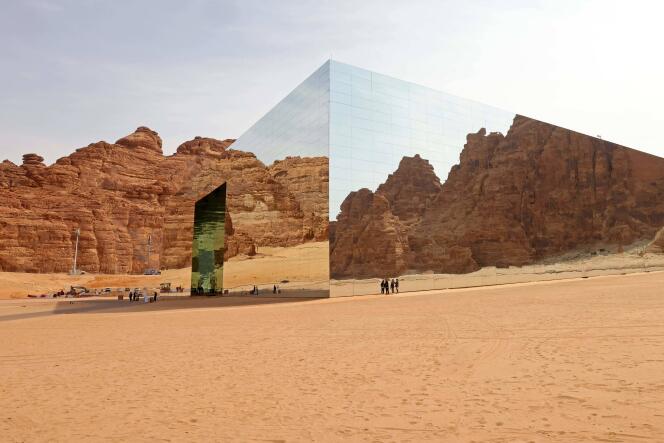
Night had not yet fallen on Al-Ula. Soon, Saudi and foreign tourists would flock to the historic center after a day spent in the canyons of this city in northern Saudi Arabia, which houses Nabatean tombs dating back more than two millennia. Sitting on the terrace of the jewelry store where she works, Hayat chatted with other saleswomen. With a discreet gesture, she lifted her black niqab, the full veil that all women wear in the kingdom, to sip her iced coffee bought at Starbucks.
"It's an opportunity for us to have all these tourists in Al-Ula. We don't have to go to Medina or Jeddah to enjoy the cafes and stores. And it creates a lot of jobs," said the 24-year-old Saudi woman, her eyes rimmed with kohl, an ancient eye cosmetic used in Saudi Arabia. Hayat took the sales job at the beginning of the high season in November after earning her master's degree in computer science. Five days a week, at the end of the day, she greets customers in the store located on the main artery of the Al-Djadida district. "It gives me professional experience while waiting to find a job in my field. I like the contact with people from all countries," she added.
A fatwa forbade the believers from going there
Saleswomen, hostesses, guides, drivers or receptionists: like Hayat, hundreds of young people in Al-Ula have gone into the tourism business. For a long time, their city remained the sleepy capital of an agricultural province the size of Belgium, offering few prospects. The majority of its 50,000 residents made their living by growing dates, lemons and oranges, and by raising camels and sheep. Few people in the kingdom, still closed to foreign visitors, walked the sandstone formations of Madain Saleh and the city of Hegra, listed as World Heritage Sites by UNESCO in 2008. A fatwa forbade believers from visiting the city, which was cursed by the Prophet Mohammed.
The fate of Al-Ula changed when Crown Prince Mohammed bin Salman made it a flagship project of his "Vision 2030" plan. This reform program aims to break the kingdom's dependence on oil and loosen the grip of the ultra-regulatory Wahhabi clergy on society. Opening up the country to tourism and developing a leisure industry is a priority for the 37-year-old prince. The Royal Commission for Al-Ula (RCU), a public body under the Crown, has been given a $35 billion budget to transform the site into a luxury tourist destination. "We are trying to integrate the project into the local ecosystem in a sustainable way. Al-Ula will never become a mass tourism destination," assured Philip Jones, one of the experts of the RCU.
You have 58.04% of this article left to read. The rest is for subscribers only.
Lecture du Monde en cours sur un autre appareil.
Vous pouvez lire Le Monde sur un seul appareil à la fois
Ce message s’affichera sur l’autre appareil.
Parce qu’une autre personne (ou vous) est en train de lire Le Monde avec ce compte sur un autre appareil.
Vous ne pouvez lire Le Monde que sur un seul appareil à la fois (ordinateur, téléphone ou tablette).
Comment ne plus voir ce message ?
En cliquant sur « Continuer à lire ici » et en vous assurant que vous êtes la seule personne à consulter Le Monde avec ce compte.
Que se passera-t-il si vous continuez à lire ici ?
Ce message s’affichera sur l’autre appareil. Ce dernier restera connecté avec ce compte.
Y a-t-il d’autres limites ?
Non. Vous pouvez vous connecter avec votre compte sur autant d’appareils que vous le souhaitez, mais en les utilisant à des moments différents.
Vous ignorez qui est l’autre personne ?
Nous vous conseillons de modifier votre mot de passe .
Lecture restreinte
Votre abonnement n’autorise pas la lecture de cet article
Pour plus d’informations, merci de contacter notre service commercial.
Islam: Sacred Spaces and Places
Although Muslims pray five times daily in their homes or wherever they are, in fact even in the streets, Muslims also worship in mosques.
Mosques can be very elaborate, large structures or very simple ones. However most have these common features:
Sahn - a courtyard surrounded by arcades called riwags. There are fountains of water inside the courtyard to symbolize purity and where worshippers can bathe before entering the mosque.
Minaret - a tower from which the muezzin calls Muslims to prayer. The minaret looks down on the sahn.
Mihrab - an empty arch which indicates the direction of Mecca.
Minbar - a pulpit from which the imam (prayer leader) gives the sermon and leads prayers.
Zulla or prayer hall off the sahn.
Mosques are decorated with a special kind of art. Muslims do not believe in making images of Allah, Muhammad, any other prophets, or any person or animal. There are two reasons for this. One is that the worship of images is forbidden in Islam. The other reason is that no artist's representation of Allah's creation would be able to show its true beauty. It is a way of honoring Allah.
So, instead, Islamic artists use geometric shapes and patterns on their walls, floors, in their holy books, and on other decorative items. Islamic mosques are known for incredible complex mosaic work. This medium suits the geometric nature of Islamic art. Stars and crescents are also found on mosques and are symbols associated with Islam. The crescent comes from the fact that Islam has a lunar calendar. In the Koran, stars are often signs from Allah.
Premium Content

- HISTORY & CULTURE
These 5 destinations are among the holiest sites in Islam
Mecca is the religion’s most iconic destination. But these exquisite mosques and shrines found from Tunisia to Syria also honor its sacred history.
With nearly two billion followers, Islam originated in Arabia and spread throughout the world, becoming the world’s second largest religion after Christianity. While Mecca is its holiest site, there are other major Muslim sites—gilded mosques, mosaic-embedded shrines, and holy cities—that not only are architectural gems but provide intriguing insights into Islam’s history and culture. Here’s a look at five of Islam’s most important sites, each one a stunning icon of the faith.
1. Mecca, Saudi Arabia
Of course, Mecca tops the list. This most holy city was the birthplace of Muhammad, around A.D. 570, but it was sacred even before he came along. Adam and Abraham, potent figures from the Abrahamic traditions, have strong links to the city. Abraham’s life, in particular, was a series of trials of his faith in God, and these inspire some of the ceremonies that Muslims perform during the hajj (pilgrimage), such as sacrificing an animal and sharing the meat with the poor.
The city’s centerpiece is an ancient granite cube, the Kaaba, standing within the Holy Mosque (Masjid al-Haram) and covered by the kiswa, a black cloth woven with verses from the Quran. Muslims across the globe bow in prayer toward the Kaaba five times daily, a ritual set by Muhammad in 624.
Muslims with the means and ability are expected to visit Mecca once in a lifetime for the hajj, known as the fifth pillar of Islam. They begin and end the hajj by walking around the Kaaba seven times.

2. Medina, Saudi Arabia
As the burial place of Muhammad and the city where the Prophet and his followers fled from attacks in Mecca, Medina—about 200 miles north of Mecca—is the second holiest site in Islam. Millions of Muslims visit each year to pray at the Prophet’s Mosque (Masjid an-Nabawi). Although neither a part of the hajj nor a duty for Muslims, this act is said to be worth more than a thousand prayers at any other mosque.
Most of the current mosque, a two-tiered structure with 27 domes and an open-air courtyard, dates from the 19th and 20th centuries. Muhammad, who built the original and died in 632, lies buried under the green central dome, along with the first two caliphs, Abu Bakr and Umar. Much expanded, the mosque can now hold more than a million worshippers, with more expansion plans under way. In addition, the mosque incorporates modern technology, such as retractable Teflon umbrellas, to counter the blasting summer heat.

3. Great Mosque of Kairouan, Kairouan, Tunisia
The Great Mosque has stood at the heart of Arab-Muslim worship for more than a thousand years. A popular saying is that if you cannot go to Mecca, seven pilgrimages to Kairouan might save your soul.
Started in A.D. 670, only 38 years after the death of the Prophet Muhammad, it was rebuilt and enlarged over the next century. The present structure is part of an expansive complex in this holy city and dates from the reign of the Arab-Muslim Aghlabid dynasty, which ruled in the Ifriqiyah region (present-day Tunisia and eastern Algeria) during the ninth century. With its buttressed walls and three-tiered minaret—the world’s oldest surviving minaret, festooned with battlements and arrow slits—the mosque was both fortress and spiritual center. Imams preached, men studied, and in time of siege, the populace took refuge here.
You May Also Like

What you need to know when travelling during Ramadan
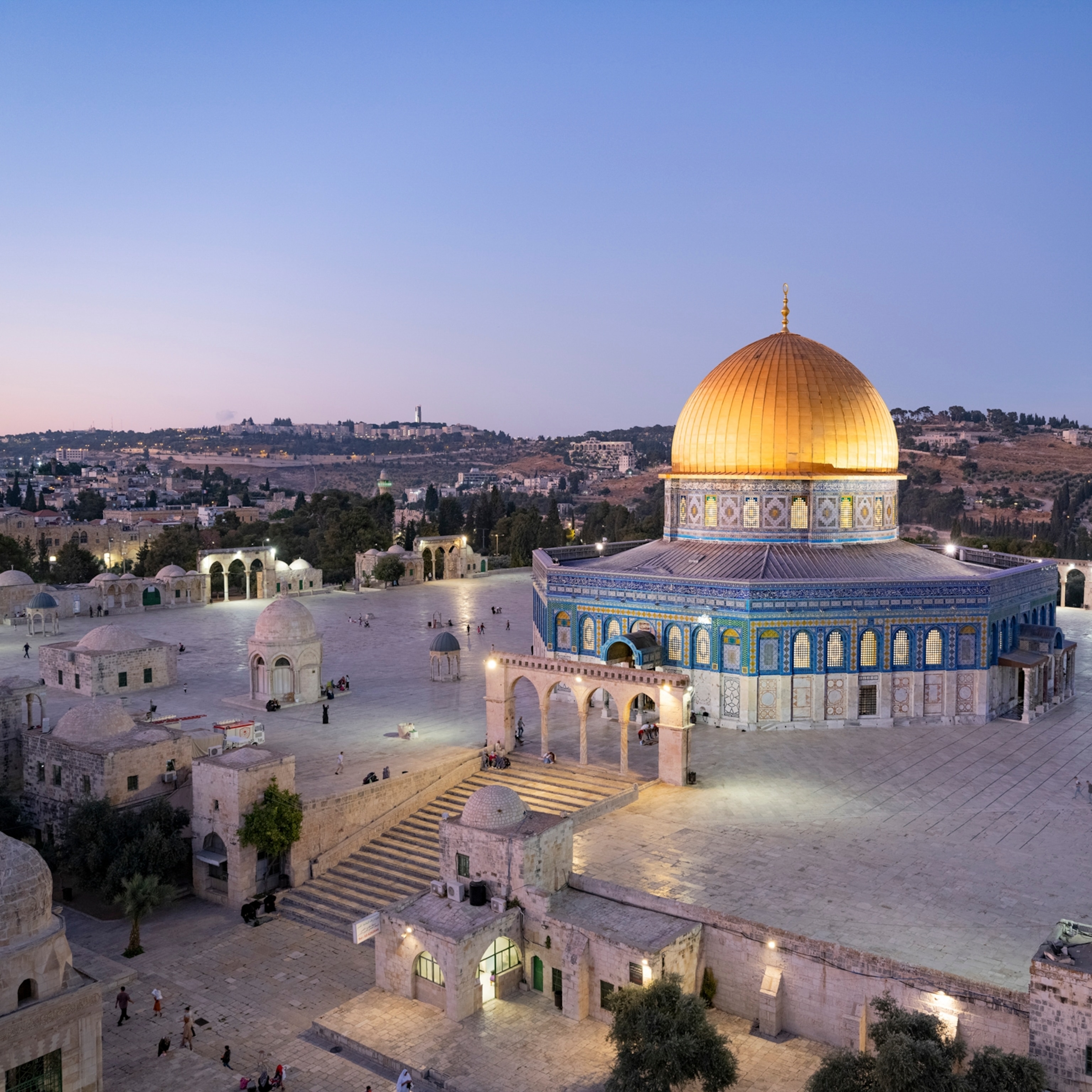
An unprecedented look inside one of Jerusalem’s holiest—and most controversial—landmarks

How do we know when Ramadan starts and ends? It’s up to the moon.
At the mosque’s center lies a dazzling white courtyard, enclosed on three sides by cloisters and columns. Exquisite marquetry covers the doors leading to the prayer room, accessible only to Muslim men. Inside is the minbar, or imam’s pulpit, thought to be the oldest surviving in the Islamic world; the mosaic-covered mihrab, a niche pointing in the direction of Mecca; and 17 naves supported by carved columns.
4. Harem al-Sharif, Jerusalem, Israel
Jews and Muslims both hold sacred the flat, elevated plaza atop Mount Moriah in the heart of Old Jerusalem. Consider the holiest site in Judaism, the Temple Mount is the the site of the demolished First and Second Temples that in biblical times served as a central place of worship for Israelites and Jews; only the Western Wall survives the Roman destruction of the Second Temple in 70 B.C.
After the Muslim conquest of Jerusalem in A.D. 638, the ruling caliph built the shrine of the Dome of the Rock on the Mount Moriah site, which is known to Muslims as Harem al-Sharif (Noble Sanctuary). It’s a beautiful structure, adorned with faience, marble, and mosaics, and its glittering gold-leaf roof forms the city’s most striking landmark to this day. At its heart is an outcrop of jagged rock where Muslims believe Muhammad ascended to heaven.
The Muslims built other structures, fountains, and gardens that sprinkle the 35-plus-acre Noble Sanctuary compound, including the silver-domed Al Aqsa Mosque, just south of the Dome of the Rock. One of the world’s largest mosques—more than 4,000 Muslims can prostrate themselves on the floor during prayer— it features the Isra, an Islamic tale of Muhammad’s Night Journey. According to this story, Muhammad is said to have traveled from Mecca to the Al Aqsa Mosque on the back of the Buraq, a winged horse-like creature, to lead other prophets in prayer.
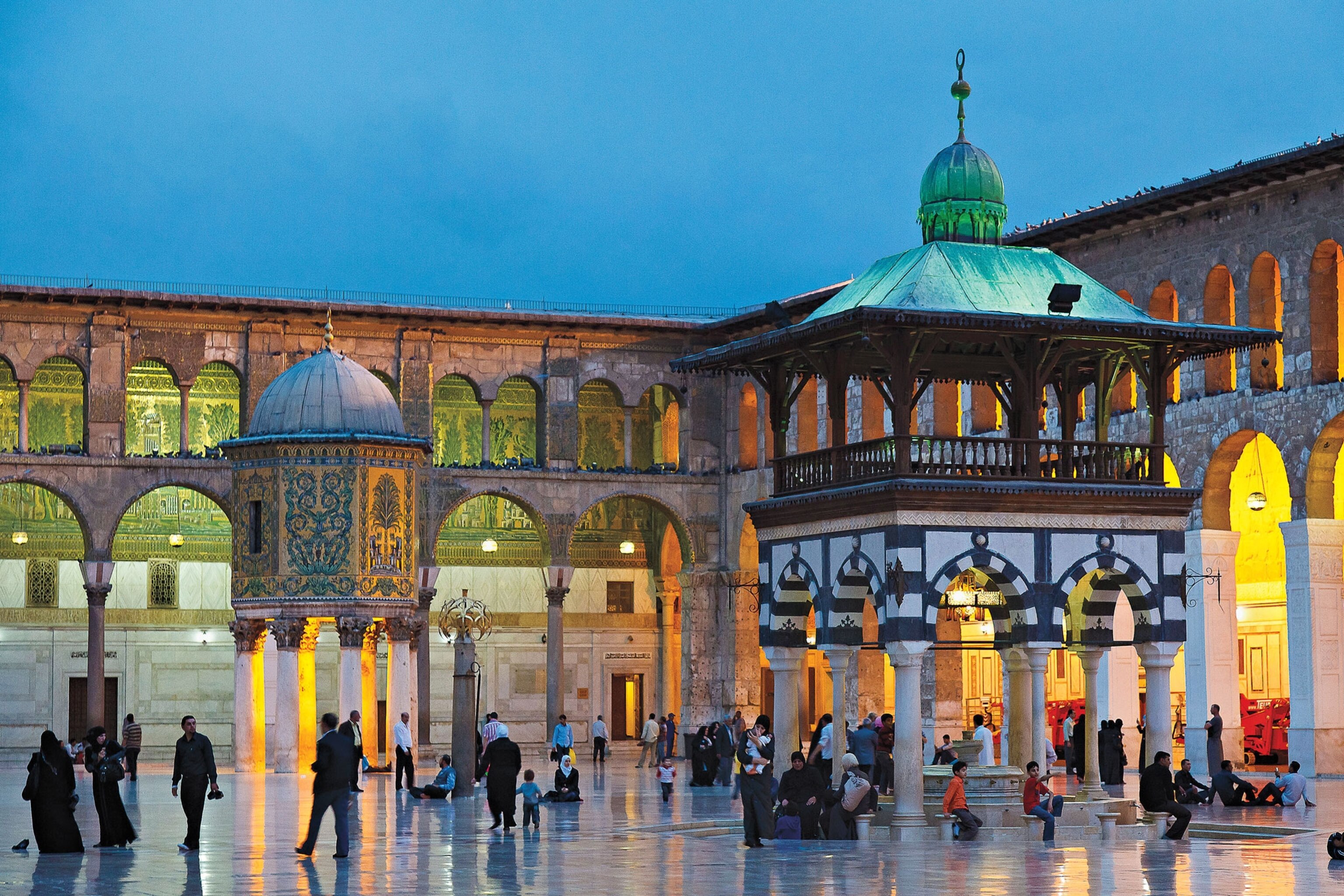
5. Umayyad Mosque, Damascus, Syria
Al-Walīd I, the caliph who built the Umayyad Mosque circa A.D. 715, famously proclaimed: “People of Damascus, four things give you a marked superiority over the rest of the world: your climate, your water, your fruits, and your baths. To these I add a fifth: this mosque.”
The mosque, also known as the Great Mosque of Damascus, stands on the site of a succession of places of worship, including a Roman temple and a Christian church. It centers on a great central courtyard surrounded by an arcade of arches, with the prayer hall covering the southern side. Within the prayer hall, an ornate domed shrine of deep green glass is believed to contain the head of St. John the Baptist, a Jewish prophet who baptized Jesus and is known to Muslims as the prophet Yahya. This part of the mosque is sacred to both Christians and Muslims. Also contained within the mosque is a shrine believed to contain the head of Hussein ibn Ali, Muhammad’s grandson whose martyrdom is frequently compared to those of John the Baptist and Jesus.
Related Topics
- ISLAMIC WORLD
- HISTORIC SITES
- PILGRIMAGES
- RELIGIOUS TRAVEL

How to visit Japan's shrines and temples—with respect

Meet Sara-la-Kali, the patron saint of displaced people

Why Ramadan is the most sacred month in Islamic culture

How to plan your pilgrimage to Montenegro‘s sacred spaces

Done the Camino? Try tackling Japan’s 88-temple Shikoku Trail
- Environment
- Paid Content
History & Culture
- History & Culture
- History Magazine
- Gory Details
- 2023 in Review
- Mind, Body, Wonder
- Terms of Use
- Privacy Policy
- Your US State Privacy Rights
- Children's Online Privacy Policy
- Interest-Based Ads
- About Nielsen Measurement
- Do Not Sell or Share My Personal Information
- Nat Geo Home
- Attend a Live Event
- Book a Trip
- Inspire Your Kids
- Shop Nat Geo
- Visit the D.C. Museum
- Learn About Our Impact
- Support Our Mission
- Advertise With Us
- Customer Service
- Renew Subscription
- Manage Your Subscription
- Work at Nat Geo
- Sign Up for Our Newsletters
- Contribute to Protect the Planet
Copyright © 1996-2015 National Geographic Society Copyright © 2015-2024 National Geographic Partners, LLC. All rights reserved

Commerce & Finance
- Palestine: Jerusalem
- Palestine: Masjid al-Aqsa
- Palestine: Other
- Makkah: Hajj places
- Makkah: Masjid al-Haram
- Makkah: Other
- Madinah: Masjid-e-Nabwi
- Madinah: Other
- Saudi Arabia: Additional places
Can non-Muslims go to Mecca or Madina? Can Tourists Enter?
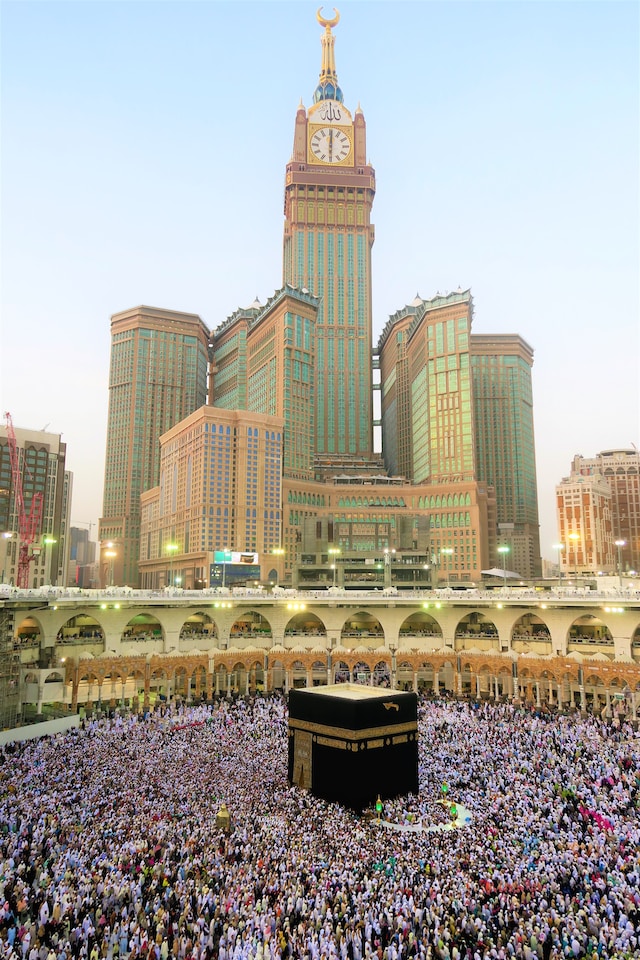
Table of Contents
Mecca and Medina are the two most important cities in the Islamic world, and millions of Muslims from around the world visit these cities each year to perform Hajj or Umrah.
However, non-Muslims are not allowed to enter Mecca, but are allowed to visit Madinah. This raises a lot of questions for people who wish to visit Mecca or Medina, especially for tourists and people of other religions.
Why Are Non-Muslims Not Allowed in Mecca or Madina?
When the question arises, ‘ Can non-Muslims go to Mecca ‘ the answer is No.
Non-Muslims are not allowed to enter the holy cities of Mecca in Saudi Arabia. The reasons for this restriction are deeply rooted in the Islamic faith and history.
Mecca and Medina are considered the holiest cities in Islam and are revered by Muslims worldwide. Mecca is home to the Kaaba, the first house of worship dedicated to the one true God, Allah. It is also the site of the annual Hajj pilgrimage , which is one of the five pillars of Islam and mandatory for every able-bodied Muslim who can afford it.
The Quran, the holy book of Islam, states that Mecca is a sanctuary that is reserved exclusively for Muslims and non-Muslims cannot vsit Mecca.
It says in the Quran,
“O you who have believed, indeed the polytheists are unclean, so let them not approach al-Masjid al-Haram after this, their [final] year” (9:28). This Quran verse is interpreted by Islamic scholars as a commandment to keep non-Muslims out of Mecca.
Furthermore, the Prophet Muhammad (SAW) declared that Mecca and Medina are sacred lands that are not to be polluted by non-Muslims.
“No unbeliever may enter Mecca. No one may circumambulate the Kaaba naked or perform the pilgrimage naked” (Sahih Muslim, 1355).
This restriction on non-Muslims entering Mecca has been in place for centuries and is strictly enforced by the Saudi Arabian government. Non-Muslims who attempt to enter Mecca can face severe consequences, including imprisonment and deportation.
The rationale behind this ban is to preserve the sanctity and purity of Mecca as holy site for Muslims . Allowing non-Muslims to enter Makkah could potentially lead to the desecration of these sacred sites and compromise their spiritual significance for Muslims.
In addition to the religious and cultural reasons, there are also security concerns that justify the ban on non-Muslims entering Mecca. The Saudi Arabian government takes the responsibility of protecting the holy cities and their visitors very seriously. It believes restricting access to these cities is necessary to ensure their safety.
How Do They Check if You Are Muslim in Mecca?
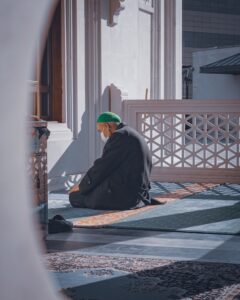
The passport will be checked at the arrival registration counter at airport when arriving in Saudi Arabia, and if the passport has any visa stamps from Israel, it will be deemed invalid.
Additionally, non-Muslims are not allowed to apply for the special Hajj or Umrah visas, which are required to enter Makkah and Medina.
Furthermore, there are checkpoints and barriers set up on the roads leading to Mecca to ensure that only Muslims enter the city.
At these checkpoints, visitors will be asked to show their Hajj or Umrah visas as well as their ID cards, which will indicate their religion.
Additionally, there are officers who will be observing the visitors’ behavior and dress to ensure that they are adhering to Islamic norms and customs.
What if I’m a Tourist Visiting Saudi Arabia?
If you are a non-Muslim tourist visiting Saudi Arabia, you will not be allowed to enter the holy citiy of Makkah. However, you can still visit other parts of the country, such as Madina, Riyadh or Jeddah, and experience the culture and hospitality of the Saudi people.
The government has also started promoting tourism in the country, and there are many tourist attractions that you can visit.
Can a Revert/Converted Muslim Go to Mecca?
Yes, a revert Muslims can of course go to Mecca.
However, it is important to note that the Saudi Arabian government has implemented strict rules and regulations for Hajj and Umrah pilgrims, and you must follow these rules to perform the pilgrimage.
Can a Christian Enter Mecca?

No, Christians are not allowed to enter Mecca. According to Islamic teachings, Christians are considered to be polytheists, and they are not allowed to enter the holy cities.
However, there have been reports of some non-Muslims being allowed to enter the cities for diplomatic or business reasons, but these are rare cases.
Can a Hindu Enter Mecca?
No, Hindus are not allowed to enter Mecca or Medina. Hindus are considered to be idolaters, and according to Islamic teachings, idolaters are not allowed to enter the holy cities.
However, there have been some exceptional cases of Hindus being allowed to enter Mecca for diplomatic or business reasons.
Can a Jew Enter Mecca?
No, Jews are not allowed to enter Mecca. The Saudi Arabian government strictly prohibits non-Muslims from entering the holy city of Mecca, and this includes Jews.
This rule is in place to preserve the sanctity and purity of the holy sites for Muslims and to prevent any potential harm to the religious and cultural identity of the city.
Is There an Age Limit for Hajj?
There is no specific age limit for Hajj, but the pilgrim must be physically and financially capable of performing the journey. However, due to safety concerns, the Saudi government has set the minimum age for performing Hajj at 12 years .
Elderly people and those with underlying health conditions are advised to consult their doctors before embarking on the Hajj journey.
What Happens if a Non-Muslim Enters Mecca?

If a Non-Muslim is found entering Mecca, they will be arrested and deported back to their country.
The Saudi government takes the ban on non-Muslims entering Mecca seriously, and violators can face severe punishment, including imprisonment and fines.
Incidents When Non-Muslims Entered Mecca
There have been instances in the past where non-Muslims have entered Mecca. In 1979, a group of armed militants led by Juhayman al-Otaybi took control of the Grand Mosque in Mecca.
The militants were from Saudi Arabia and Yemen, and they believed that the ruling Saudi monarchy had become corrupt and unIslamic.
The Saudi government eventually regained control of the mosque after a two-week siege, during which many people were killed or injured. This incident highlighted the potential security risks that non-Muslims could pose if they were allowed to enter Mecca.
In 2002, an American Jew and TV journalist in Israel named Gil Tamary secretly entered Mecca to record footage for a travelogue.
Despite the strict enforcement of the ban on non-Muslims in Mecca, Tamary managed to gain entry along with only 17 other non-Muslims known to have done so in recent decades.
The incident caused an uproar among Muslims, Israelis, and Westerners alike, as they feared it would increase hostility. The Saudi government pressed criminal charges against Tamary and his Saudi driver.
Tamary later issued an apology and claimed his intention was to highlight the significance of Mecca and the beauty of the religion to promote religious tolerance.
These incidents demonstrate the importance that Muslims place on the sanctity of Mecca and the need for strict measures to prevent non-Muslims from entering the city.
While there may be some curiosity among non-Muslims about what lies inside the holy city, it is important to respect the religious beliefs and practices of others and refrain from attempting to enter Mecca without permission.
Can Non-Muslim Enter Mosques?
Non-Muslims are allowed and welcomed to enter mosques in Saudi Arabia, however the only mosques they are not allowed to enter is Masjid Al Haram and sacred areas around it.
In many Muslim-majority countries, non-Muslims are allowed to enter mosques, although there may be certain restrictions or protocols that they need to follow, such as dress code and behavior. Visitors are often required to remove their shoes and dress modestly, and photography and loud talking may not be allowed.
In some cases, non-Muslims may be allowed to enter mosques but only in certain areas, such as a designated viewing area or the outer courtyard. In other cases, non-Muslims may be allowed to enter the mosque but only during certain times, such as outside of prayer times. But in most cases non Muslims are welcomed to visit mosques.
There are times when some mosques that do not allow non-Muslims to enter at all. This may be because the mosque is considered to be a particularly sensitive or sacred site or because there have been security concerns in the past.
In general, it is recommended that non-Muslims who wish to visit a mosque should be respectful of Islamic customs and traditions. This may include dressing modestly, removing shoes before entering the mosque, and refraining from any behavior that could be seen as disrespectful or disruptive.
Overall, non-Muslims are permitted to enter mosques, unless that mosque is Masjid Al Haram. With proper respect and consideration for Islamic customs and traditions, it is often possible for non-Muslims to visit and appreciate these important cultural and religious sites.
Islam Is Not the Only Religion That Bans/Restricts Access to Holy Sites
It is important to note that Islam is not the only religion that restricts access to certain holy sites. Many religions around the world have similar practices, and it is often done to preserve the sanctity and religious significance of these places.
For example, in Hinduism, non-Hindus are not allowed to enter certain temples.
In addition, there are also many secular restrictions on access to certain areas around the world, such as military zones, national parks, and private property.
Summary – Can Non-Muslims Go to Mecca or Medina?
The bottom line is non-Muslims are generally not allowed to enter Mecca, which are considered the holiest cities in Islam. This is due to the religious significance of these places and the Islamic belief that only Muslims are allowed to enter.
There are strict checkpoints and guidelines in place to ensure that only Muslims are able to enter, and those who attempt to enter without permission may face severe consequences.
However, tourists and visitors to Saudi Arabia are still able to experience the culture and history of the country, and there are many other places to visit and explore.
It is important to be respectful of local customs and traditions and to follow all laws and regulations while visiting the country.
Browse by place

Download our free Ziyarah guides

You may also like
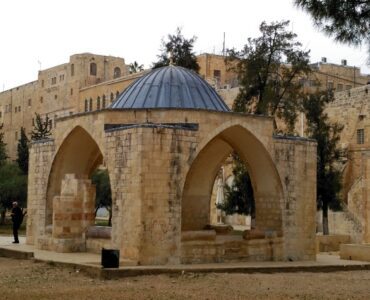
Dome of the Lovers of the Prophet
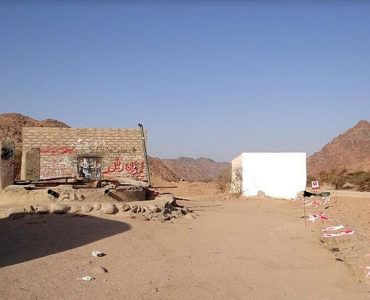
Gate of the Chain minaret
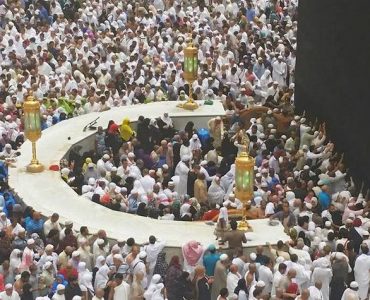
Hateem/Hijr Ismail
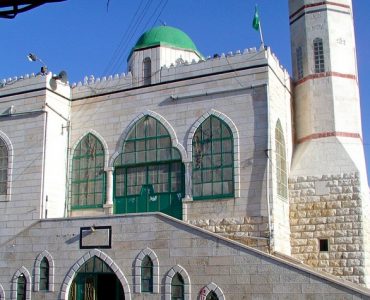
Mosque of Prophet Yunus (عليه السلام)
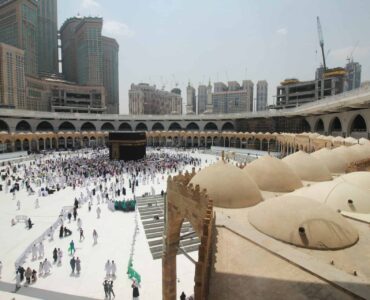
Hajj Badal – The Proxy Hajj – Perform Major Pilgrimage on Behalf of Someone
Find answers to over 300 Hajj and Umrah questions
About this site
Please note that some of the places featured on this site cannot be verified for certain. The knowledge of these places has been passed down through the ages and in some cases more than one location make claim to hosting the same historical place. In such instances IslamicLandmarks.com has shown the most commonly believed site. And Allah (ﷻ) knows best.
Our social media channels
If you've benefitted from this website please consider making a donation . It will help us to expand the site and create more functionality which will insha'Allah benefit many others.
Stay up to date and informed on:

0 Visitors since 2020

Saudi antiquities site, long seen as haunted, tries to woo visitors
- Medium Text
Writing by Stephen Kalin; Editing by Alison Williams
Our Standards: The Thomson Reuters Trust Principles. New Tab , opens new tab
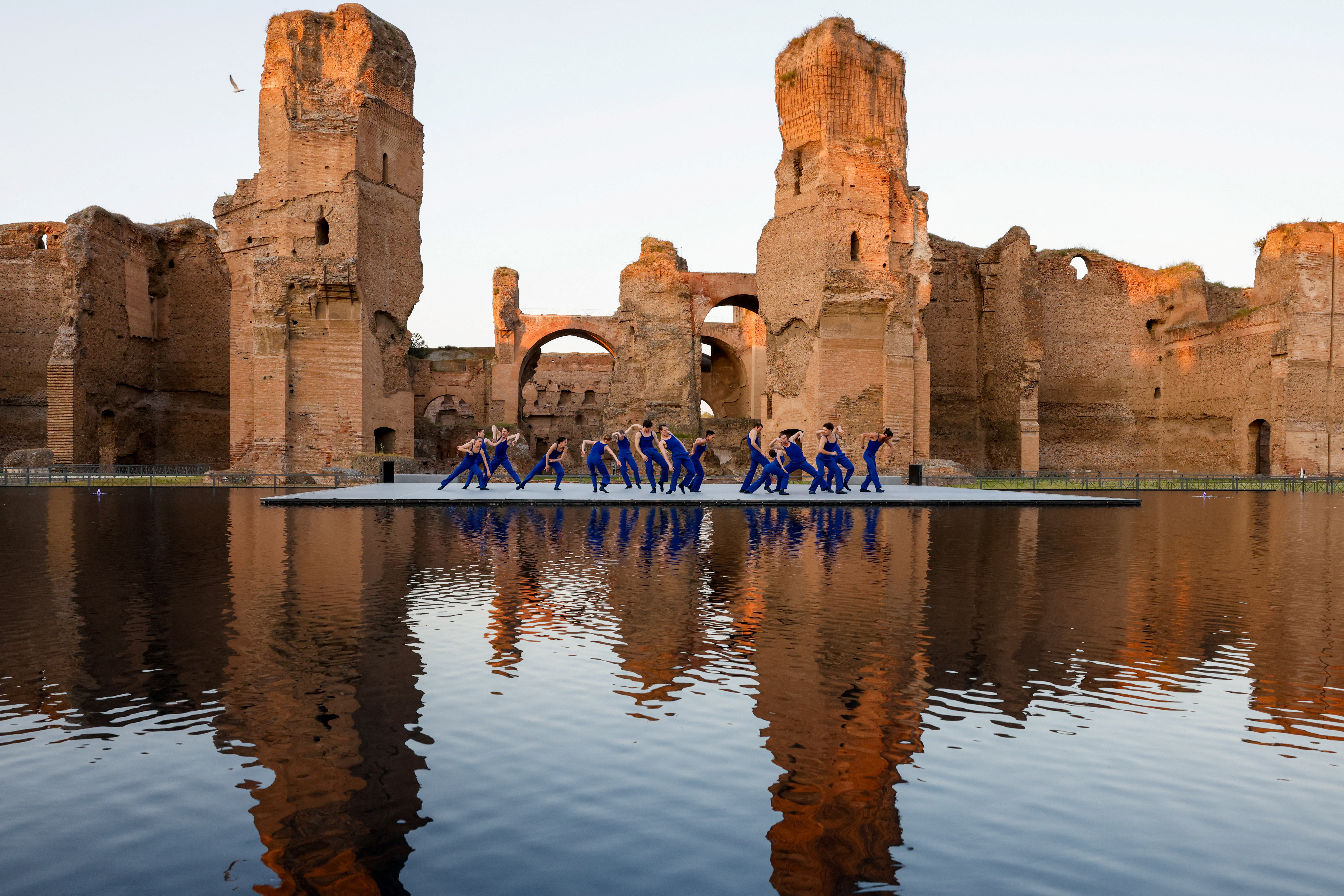
The "Golden Bachelor" reality TV couple, who wed on national television after a romance that captivated viewers with the possibility of finding love late in life, announced on Friday they are divorcing just three months into their marriage.
As Mexican banda music scales new heights globally, a festering dispute in the genre's traditional home turf pits frustrated hotel owners against the strolling ensembles that play songs on the beach at all hours of the day and night.

Lifestyle Chevron

17 Forbidden Places You Can't Visit
By michele debczak | jul 5, 2021.

From an island infested with snakes to a vault holding a very special secret recipe, check out a few of the many dangerous, mysterious, or otherwise forbidden places are off-limits to the general public, adapted from an episode of The List Show on YouTube.
1. Ilha da Queimada Grande
Ilha da Queimada Grande, or “Snake Island,” is an island off the coast of Brazil that’s home to a rare and incredibly deadly species of snake called the golden lancehead. According to some estimates, there are one to five snakes for every square meter of land on the 43-hectare island. (A population survey of the area indicated that those numbers are probably an exaggeration, but even so, there are definitely a lot of snakes on the island.)
The vipers mainly eat the migratory birds that visit the island, and they’ve evolved a venomous bite strong enough to take down their prey before they can fly away. The snakes are so dangerous that the Brazilian government has forbidden people from visiting the area. Rare exceptions are made, mostly for scientists studying the species, but they have to be accompanied by a doctor —just in case.
2. Lascaux Cave

Though not many people are eager to go to Snake Island, you may be sad to hear that you can’t visit Lascaux Cave in France. Discovered in 1940, the cavern contains some of the most iconic cave paintings ever studied. The sketches of horses, deer, and other animals date back to the Upper Paleolithic period, 15,000 to 17,000 years ago. The cave opened to the public in 1948 and closed permanently after just 15 years. The artificial lights installed there had been promoting algae growth on the cave walls and causing the painting’s colors to fade. (The microbes humans brought in with them apparently weren’t helping, either.) Lascaux Cave is now off-limits to visitors, but archaeology fans can check out a perfect replica of the site located right next door.
3. Ise Grand Shrine
The first iteration of this Shinto shrine in Japan was constructed around 2000 years ago, and since the late 7th century , it’s been torn down and rebuilt every two decades. This tradition symbolizes the Shinto concepts of death and rebirth, but it has practical purposes as well. Reconstructing the shrine about once a generation helps keep the traditional shinmei-zukuri architectural style alive. Wood also has a shorter lifespan than most building materials, so demolishing the shrine before it can rot is a way to beat nature at its own game.
When Ise Grand is rebuilt, every detail of the ornate design has to be replicated, making it one of the most expensive structures in the country. Reconstructing Ise Grand and its hundreds of secondary shrines costs the Japanese government $500 million each time, and most of that cost and effort ends up going unseen: While tourists can view it from the outside, the inside of the shrine is only accessible to the highest priestesses or priests.
4. The Svalbard Global Seed Vault
The Svalbard Global Seed Vault is located on the remote Arctic island of Spitsbergen in Norway. The 11,000-square-foot space houses more than 1 million seed samples native to places around the world. The vault acts as a sort of back-up drive of the world’s crops, preserving specimens in a safe place in case a disaster ever wipes them out in their natural environment. The facility is built to protect its contents from unwanted visitors along with everything else. It’s deep enough underground and high enough above sea level to withstand earthquakes, ocean rise, and nuclear attacks.
5. The Vatican's Secret Archives
Millions of people visit the Vatican in Rome each year, but there's at least one area in the tiny sovereign state that's strictly off-limits. Established in 1612 , the Vatican Apostolic Archive (formerly the Vatican’s Secret Archives) contains the personal documents of all the popes. The archives were completely classified until 1881, when Pope Leo XIII gave Catholic scholars special access to the materials. Today, the collection remains closed to everyone but certain accredited scholars. Researchers who are allowed inside can request up to five files a day, but they have to know exactly what they want because browsing is forbidden. Who knows what we’d find out if they let Tom Hanks run loose in there for a few hours.
6. Coca-Cola’s Vault

The World of Coca-Cola Museum in Atlanta, Georgia, is the site of a multi-million dollar vault that’s said to safe-guard Coke’s secret formula. Tourists can see it from the outside, but the interior is strictly limited to top executives. Though the vault itself is likely a publicity stunt, the formula is apparently a real, handwritten recipe that’s been in the company’s possession since at least the 1920s. It sat in a safe deposit box at an Atlanta bank for decades before moving to its current home at the World of Coca-Cola in 2011. Despite all that trouble, Coke’s secret formula may not be much of a secret at all. That same year, This American Life shared a recipe for Coke that had allegedly been passed down from a mysterious pharmacist. Coca-Cola, of course, denies that this formula is the same one they have locked away.
7. Uluru (Formerly Ayers Rock)
One of the world’s most famous forbidden places hasn't been forbidden for that long. In October 2019, Uluru , or the Australian landmark formerly known as Ayers Rock, closed to the public. Climbers had been trekking to the outback for decades just to scale the iconic rock formation. But long before it was a tourist attraction, Uluru was a sacred place to Indigenous groups. Following petitions from the Anangu people, the board of the Uluru-Kata Tjuta National Park finally announced plans in 2017 to ban hikers from the site for good. (You can still visit the area, but climbing the rock is forbidden.) In case that isn’t enough to keep people away, there are also rumors of a curse that targets disrespectful tourists. Visitors who have collected rocks from Uluru have reported streaks of bad luck, and enough of the cursed keepsakes have been mailed back to park rangers to earn them the nickname “sorry rocks.”
8. The Island of Surtsey
In the 1960s, an undersea volcanic eruption created a brand-new island off the coast of Iceland. It’s not every day that scientists get to study an island from the moment it emerges, so they decided to make the most of the opportunity. The island, named Surtsey, has become a case study for how ecosystems develop without any interference from humans. (Other than the ideally noninterventionist scientists who study the island, that is.) Some of the lifeforms that have found their way to Surtsey include molds, fungi, at least 89 bird species, and, supposedly, one plucky tomato plant.
In 1969, an Icelandic scientist named Ágúst Bjarnason was asked to make a trip to Surtsey to identify a mysterious plant, which he identified as a tomato. Bjarnason looked into the situation a bit further; as he later recalled, “Someone had done their business … and this beautiful tomato plant … had grown out of the feces.”
Fun fact: In Iceland, a euphemism for going no. 2, which Bjarnason used in relating his tale, can be roughly translated as “playing chess with the pope.”
9. Heard Island, the Home of Mawson Peak
Some islands are off-limits for the public’s own good. Heard Island in Antarctica is an Australian territory, and it’s one of the more dangerous places on Earth. A 9000-foot-tall volcano on the island named Mawson Peak has been active since at least 2000 , and wind speeds there average around 20 mph . While you could apply for a permit to visit the island, getting there wouldn’t be easy: Heard Island is at least a two-week’s journey by boat from Australia.
10. Montserrat’s Designated Exclusion Zone
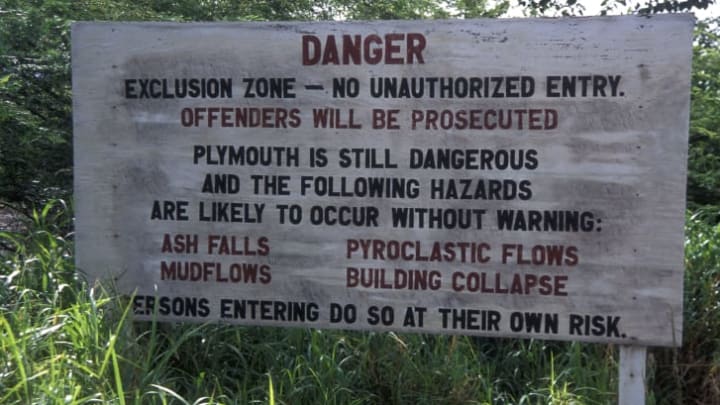
Thankfully no one was around when Mawson Peak became active, but that wasn’t the case on the Caribbean island of Montserrat in the 1990s. When the Soufrière Hills volcano awoke from dormancy in 1995 , the nearby town of Plymouth was evacuated and eventually abandoned altogether as eruptions continued. Ash consumed the town, turning it in a modern-day Pompeii. While the volcano is not as destructive as it was a few decades ago, there’s a chance it could erupt again, which means more than half the island is still a designated exclusion zone .
11. Chernobyl Exclusion Zone
Following the meltdown at the Chernobyl Nuclear Power Plant in Ukraine in 1986, a 18-mile radius exclusion zone was established around the site. Though it's still against the law to live there, you can take a day trip with a licensed guide. Most of the exclusion zone is now open to tourists, including the infamous Reactor 4 control room where the disaster took place. You'll need a hazmat suit to enter the control room, but you can get away with long-sleeved clothing outside the power plant.

12. Area 51
Area 51 is famously off-limits to the public. The government refused to acknowledge its existence until 2013 , when they finally admitted there was indeed a “flight testing facility” in the Nevada desert. Its restricted status didn’t stop people from planning a raid on Area 51 in September 2019. Though more than 2 million people RSVP’d to the “Storm Area 51” event on Facebook, only a few dozen showed up at the gates at the appointed time. The would-be stormers were quickly forced to leave by authorities, meaning the truth is still out there.
13. North Korea’s Room 39
North Korea's version of Area 51 is Room 39, but instead of military secrets, it's said to hide things like black market Viagra . The name refers to the secret department as a whole, but it’s also believed to be the name of a real office in the Workers Party building in the North Korean capital of Pyongyang. According to some defectors , it keeps foreign cash flowing into the pockets of elite officials. Illegal activities coming out of Room 39, such as counterfeiting, insurance scams, and drug production, along with some legal endeavors, are estimated to make the country between $500 million and $2 billion USD. Of course, the country’s notorious secrecy makes all of this hard to confirm.
14. The Island of Poveglia
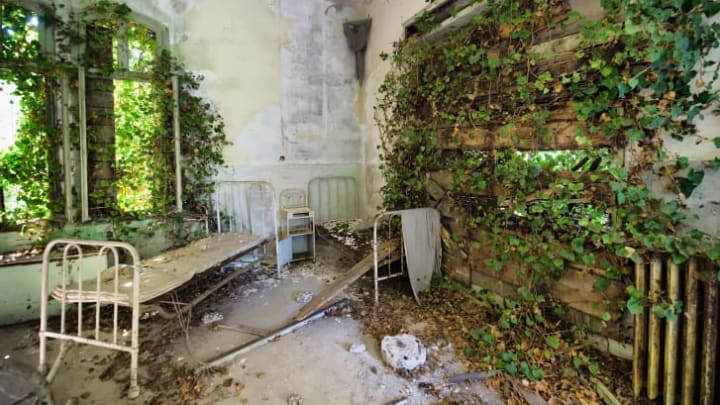
Poveglia in Italy is deserted today, but it’s been said that over the years, 160,000 people have lived, and died, there. The Venetian island became a quarantine station in 1793, and for two decades it was a place for potential victims of the bubonic plague. So many people died there that up to 50 percent of the island’s soil is said to contain human remains. The quarantine station closed in 1814, but Poveglia’s dark history didn’t end there. A mental hospital opened at the site in the 1920s, and it quickly developed a reputation for its inhumane treatment of patients . The hospital closed after a few decades, and today the overgrown island is largely closed off to visitors—except for the occasional ghost hunters .
15. North Brother Island
New York City is also home to an abandoned quarantine island. In the late 19th century, North Brother Island on the East River became the site of a hospital for patients with contagious diseases. Its most famous patient was Typhoid Mary , America’s first known asymptomatic carrier of the bacterium responsible for typhoid fever. Mary Mallon unknowingly got dozens of people sick while working as a cook in the early 1900s. She spent three years quarantined on North Brother Island after the first outbreak she caused, and when she was eventually released, she went back to cooking and infected even more people. Mary was sent back to the hospital against her will in 1915 and lived there until her death in 1938. The deserted island now serves a much happier purpose as a bird sanctuary . It’s inaccessible to the general public, but the city does make some exceptions for visitors with “compelling academic and scientific” reasons to visit.
16. Heart Reef
Heart Reef, which is part of Australia’s Great Barrier Reef, is a serious candidate for “world’s most photogenic location.” As the name suggests, the reef is shaped like a heart, and it’s been the subject of countless Instagram posts and tourism campaigns . It may be iconic, but you can’t actually see the landmark up close. Divers and snorkelers have been banned from the spot to protect it from damage. So if you want to snap that perfect vacation pic without hurting a delicate ecosystem, you’ll need to pay for a helicopter ride.
17. The Ethiopian Church That Claims to Hold the Ark of the Covenant
Ethiopia claims that it’s home to the Ark of the Covenant. It’s kept in a church in the city of Aksum that’s so closely guarded, even Indiana Jones would have trouble getting in. According to legend, the monks who guard the treasure have been trained to kill with their bare hands . By some accounts, only the monk who is designated as guardian is able to see the Ark, and after assuming his role he isn’t allowed to leave the church grounds for the remainder of his life. The secrecy and potential myth-making means that archaeologists haven’t been able to confirm the Ark’s legitimacy. A British historian who claimed to have seen it during World War II said that it’s actually a medieval-era replica .
BONUS: Maya Bay
Maya Bay in Thailand was also shut down to protect its environment from visitors, but the closure is only temporary. Following the release of the Leonardo DiCaprio movie The Beach in 2000, Maya Bay became a popular tourist destination. The beach was attracting millions of people a year at its peak, which wiped out a lot of the coral native to the area. Thailand made the decision to close Maya Bay in June 2018 to give the ecosystem a chance to recover. The beach officially reopened in January 2022 with new rules for visitors .
A version of this story ran in 2021; it has been updated to reflect the fact that Maya Beach has reopened.
- Discover Islam
- Quran Recitations

- Medical Issues, Media, Culture and Means of Entertainment
- Means of Entertainment
Traveling To Non-Muslim Countries For Tourism

Assalamu aleykum va rahmatullah!As we know, it is forbidden to travel to non-muslim countries for purposes of tourism or unless there is a valid shari' excuse.1- What if a country that you want to travel to is a non-muslim country, but it has a region or some regions inside itself where only or mostly muslims live? Is travel for tourism to this region only permitted in this case even though this region is part of a bigger non-muslim country? For example, travelling to Daghestan or Tatarstan that are part of Russia, but in these regions the majority of population is muslim? 2- The same question, but if in this case the muslim country you are living in has more munkar or the same level of munkar than the non-muslim country you're going to travel to? I mean that in terms if fitnah it wouldn't make a difference for you or maybe the non-muslim country you're travelling to will have less fitnah than it is in your country. Is it permissible then to travel to non-muslim country in this case? I'm asking this because scientists forbid going to non-muslim countries because of the fitnah a muslim can get into or because it could influence his imaan, but in this case there will be mainly no infulence for a muslim. 3 - But what should muslims do who were born and are living in those non-muslim countries? These countries are their native countries. Are they also forbidden living in those countries and they all have to move to other muslim countries? For example, americans or russians who were born on those countries and who are muslims?Could you please support your answer with quotes from scientists and from Quran & sunna where possible? May Allah be pleased with you!
First of all, you should know that in principle it is permissible to travel for tourism, sightseeing, and recreation. Allah Says (what means): { Say, “Who has forbidden the adornment of Allah which He has produced for His servants and the good [lawful] things of provision?”. } [Quran 7:32]
The prohibition of travelling to non-Muslim countries is for a reason and it is not the basic principle ruling. The reason for the prohibition is the fear of temptation in one’s religion, whether in misconceptions or desires.
To prevent traveling –whether it means prohibited or disliked– is because of the danger in that country on one’s creed, religion and morals.
It is established that the ruling depends on the reason: if the reason for prohibiting something exists, then it is prohibited, and if does not, then it is allowed.
Therefore, if such a reason exists when travelling to some Muslim countries, such as where immorality and dissoluteness are widespread, and the traveler to these countries will not be safe about his manners and risks getting deviated and falling into the swamp of immorality, then he is forbidden from traveling to them even if they are Muslim countries. The Sharee’ah does not differentiate between two identical things, and it does not consider two different things as being the same.
“ The Sharee’ah of Allaah is established on the fact that the ruling on something is the same ruling as something that is identical to it. Hence, The Sharee’ah of Allah does not differentiate between two identical things at all, and it never considers two contradictory things as being the same thing. Whoever believes otherwise, then it is either due to his lack of knowledge of the Sharee’ah, or because of his negligence in knowing when two matters are similar and when they are different. ” [End of quote]
This is the reality. Many Muslim countries became a resort for dissolute and disobedient people who travel to them in order to fulfill their forbidden desires. There is absolutely no difference between these countries and non-Muslim countries in this regard; it is forbidden to travel for tourism to such countries. It is for this reason that the scholars stated that it is disliked to travel to Muslim countries where sins and innovations are widespread and they considered the ruling of traveling to these Muslim countries and emigrating from them the same as travelling to non-Muslim countries and migrating from them.
Al- Bahooti , from the Hanbali School of jurisprudence, said in his book Kash-Shaaf Al-Qinaa’:
“ Trade and travel are absolutely forbidden to the land of the enemy and to non-Muslim countries, whether one will feel secured there or fears (for himself and his faith). The same applies regarding traveling to the country of the Khawaarij (Kharijites), tyrants, Raafidhah, or a land where there are misguiding innovations, and the like, because emigrating from these countries if one was living in them is desirable if he is able to practice his religion. However, if he is unable to practice his religion in them, then it is forbidden for him to travel to them (if he is outside) because, by doing so, he subjects himself to disobedience. ” [End of quote]
The ruling of travelling to the land of Muslims where evil matters are widespread to the extent that it is almost like the non-Muslim country does not differ from the ruling of travelling to the land of Kufr (non-Muslims). Similarly, the ruling of migrating from those Muslim countries, for whoever lives in them, does not differ from the ruling of migrating from the non-Muslims countries as already mentioned in Kash-Shaaf Al-Qinaa’.
Allah knows best.
Related Fatwa

Traveling to countries that permit sinning
Traveling for tourism – an islamic view, ruling on honey moon, going to the dead sea for entertainment, muslims sight seeing in churches, tourism brings non-believers, black color is not condition in clothes of muslim women, search fatwa.
You can search for fatwa through many choices
Fatwa Subject
- The Noble Quran
- Noble Hadeeth
- Islamic Creed
- Religions, Sects and Da'wah (Call to Islam)
- Seerah (Biography of the Prophet)
- Merits and Virtues
- Etiquettes, Morals, Thikr and Du'aa'
- Tahaarah (Ritual Purity)
- Salah (Prayer)
- Funeral: Prayer and Rulings
- Zakaah (Obligatory Charity)
- Siyaam (Fasting)
- Hajj and 'Umrah
- Fiqh of Transactions and Inheritance
- Women and Family
- Foods, Drinks, Clothes and Adornment
- Jinaayaat (Criminology) and Islamic Judicial System
- Islamic Politics and International Affairs
- Miscellaneous
- OTHER ISSUES

- Islamic Songs
Special Folders
- Hajj & Umrah
- Xmas & New Year's
- Sacred Months
- Inheritance
- Prayer Times
- Calendar Converter

Copyright © IslamWeb 2024. All rights reserved.

- Albalagh.net
- AnswersToFatawa
- Arij Canada
- Askimam.org
- Askmufti.co.za
- AskOurImam.com
- CouncilofUlama.co.za
- Darulfiqh.com
- Darulifta Azaadville
- Darulifta Deoband Waqf
- Darulifta-Deoband.com
- Daruliftaa.com
- DaruliftaaMW.com
- DaruliftaaZambia.com
- DarulIftaBirmingham
- Darulihsan.com
- DarulUloomTT.net
- Fatwa-TT.com
- Fatwa.org.au
- FatwaCentre.org
- HadithAnswers.com
- IslamicPortal.co.uk
- IslamicSolutions.org
- Jamia Binoria
- Mahmoodiyah
- Mathabah.org
- Muftionline.co.za
- Muftisays.com
- MuslimaCoaching.com
- Seekersguidance.org
- ShariahBoard.org
- Tafseer Raheemi
- TheMufti.com
- ZamzamAcademy.com
- BinBayyah.net
- Darul Iftaa Jordan
- Shafiifiqh.com
- HanbaliDisciples.com
- TheHanbaliMadhhab.com
- Ask Question
- Lailatul Qadr

Home » Hanafi Fiqh » Daruliftaa.com » Ruling on Visiting Graves
Related Q&A
- I would like to know what is the shariah ruling regarding women going to the cemetary. If possible, please give references from quran and hadith.
- Is it permissible for women to visit graves?
- Visiting Graves: Proper Manners & Reasons
- I would like to know if my sister who is 19 years of age,dresses islamically and respectfully should visit the graveyards o the holy saints(MAZAAR'S)?
- Females Visiting Graves
- Sallam is it permissible for women to visit the grave yard and visit the dead and pray faatiah there.
Ruling on Visiting Graves
Is it permissible for one to visit the graves of the saints, pious and other Muslims? Some people say that it is unlawful to visit graves. Can you explain the ruling on this with evidence from the Sunnah? Also, if it is permissible, then what are the benefits in doing so?
In the name of Allah, Most Compassionate, Most Merciful,
It is the understanding of the Ahl al-Sunnah wa al-Jama’ah that, visiting graves in general and the graves of the prophets, pious and saints in particular, is not just something that is permissible, rather recommended (mandub) and rewarding.
There are many prophetic traditions in this regard, just to mention a few:
1) Ibn Buraida narrates from his father that the Messenger of Allah (Allah bless him & give him peace) said: “I used to forbid you from visiting graves. Now, do visit them…” (Sahih Muslim, no. 977)
2) Sayyida A’isha (Allah be pleased with her) narrates that “Whenever it was her turn to spend the night with the Messenger of Allah (Allah bless him & give him peace), he used to go to the Baqi (graveyard) in the last portion of the night and say: “May you be safe, O abode of the believing people. What you have been promised has come to you. You are tarried till tomorrow and certainly we shall follow you if Allah wills. O Allah, forgive the inmates of the Baqi-al-Gharqad.” (Sahih Muslim, no. 974)
3) Sayyiduna Abu Huraira (Allah be pleased with him) narrates that the Messenger of Allah (Allah bless him & give him peace) said: “…Visit graves, for it reminds one of his death.” (Sahih Muslim, no. 976)
4) Sayyiduna Abd Allah ibn Mas’ud (may Allah be pleased with him) narrates that the Messenger of Allah (Allah bless him & give him peace) said: “I used to forbid you from visiting graves. Now, do visit them, for it (visiting graves) makes one ascetic of the world and reminds one of the hereafter.” (Sunan Ibn Majah, no. 1571)
5) Sayyida A’isha (may Allah be pleased with her) says: “The Messenger of Allah (Allah bless him & give him peace) gave permission in the visitation of graves.” (Sunan Ibn Majah, no. 1570)
The above and many other narrations of the Messenger of Allah (Allah bless him & give him peace) are more than sufficient to prove the permissibility and desirability of visiting graves.
There are many reasons for visiting graves, such as:
a) It is a Sunnah of the Messenger of Allah (Allah bless him & give him peace), as we have seen in Hadith no. 2, quoted above; b) It reminds, the person visiting, of death, as mentioned in Hadith no 3;
c) It reminds, the person visiting, of the purpose of one’s life and helps him in removing the love of this world from his heart and striving in the betterment of the hereafter;
d) One benefits from the baraka of the person visited if one goes with a good intention, whether one realizes it or not. Those with more spiritual clarity realize this more clearly;
e) It benefits the one visited, because of the reward of recital of Qur’an (and other matters) one makes.
Having said the above, one must always remember not to engage oneself in any unlawful and blameworthy act when visiting graves, such as prostrating (sajda) to the graves, which is undeniably a grave sin, if not Kufr. Similarly, excessive mourning, crying and wailing has also been prohibited by the Messenger of Allah (Allah bless him & give him peace). Intermingling of the sexes at the graves of many saints is very common, which is unlawful, and must be avoided.
Thus, all acts that are unlawful or innovation must be avoided when visiting graves. If one avoids such matters, and visits the graves by observing the proper manners (adab) and etiquettes of visiting, then not only will visiting graves be permissible, rather it will be regarded as an commendable act of virtue.
And Allah Knows Best
[Mufti] Muhammad ibn Adam Darul Iftaa Leicester , UK
This answer was collected from Daruliftaa.com , which is headed by Mufti Muhammad ibn Adam Al-Kawthari . He’s based in the United Kingdom.
Read answers with similar topics:
Random Q&A
I am working in saudi arabia and i have 2 children. by grace of allah in coming april i am expecting a new baby. my 2 children born by major operation and doctor told me the chances of 3rd are very high through operation. now my wife is interested to stop the pregnancy during this operation on permanent basis…, important traits to look for in a prospective spouse, how should a sahibut tarteeb qadha his salah, is it permissible to use the money received from ppi (payment protection insurance) claims, blood tests, injections and fasting, sometimes my mother indulges in practises which are very strange, and i feel are bida’h. for example, she takes eggs and circles the eggs around my head 7 times, more answers….
- Is Salaam Halal Insurance Really Halal?
- Breast Surgery if Breasts Become Ugly or Unsightly
- I live in the city of Belfast and work in Portadown a town 27 miles away. I work shifts. One week from Monday to Friday I work from 7am till 3pm the next week I work from 3.pm till 11pm this then rotates weekly. The issue is I miss the prayer on the 7am to 3pm shift. I have a dispensation at work for praying in the plant but this does not go as far as leaving work to go to the Masjid. There is a Musalla near Portadown in which I pray Jumu’ah on the 3pm to 11pm just before I start my shift. There is a chance that I may be put on a 3 way shift which will mean another shift from 11pm to 7am which will mean I will miss the prayer every 3rd week instead of every 2nd. What should I do in this situation?
- Wife Applying for a Decree Absolute after the Husband Initiates a Legal Divorce
- The Fiqh of Insistence & Deeming Necessary, and Kissing Thumbs During Adhan
- Partnership and Taking out an Interest-Based Loan
Latest Q&A
- Is Makeup Allowed During Iḥrām?
- Do These Actions Formulate Disbelief?
- The Status of a Job Acquired with False Certification
- Can a Ḥanafī Resident Pray Behind a Shāfi’īe Traveller?
- Is it Permissible to Allow Wheelchairs in a Masjid?
- Is an Entry Fee at a Charity Event Considered Charity?
Indexed Websites
Privacy overview.
- Give Your Zakat
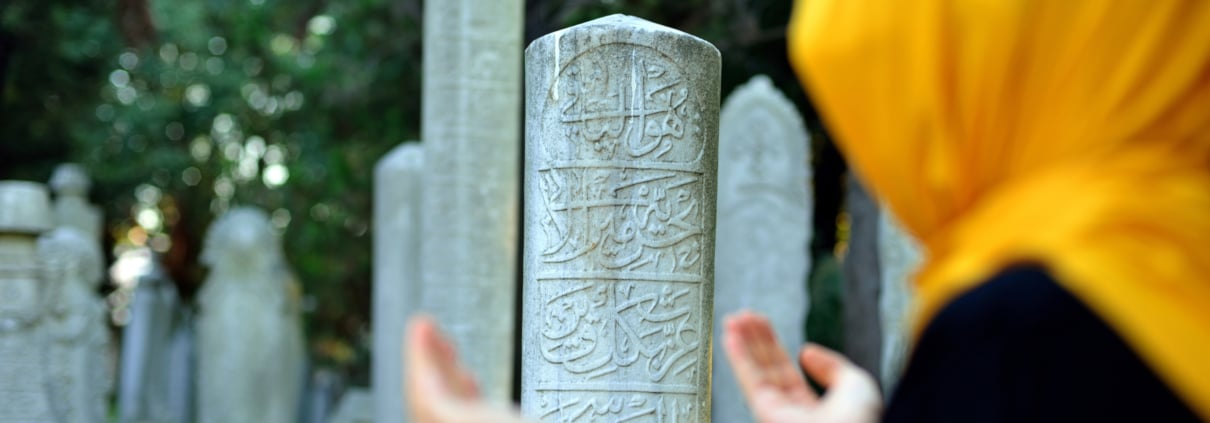
Forgotten Sunnas: Visiting Graves
Forgotten sunnas of visiting graves.
In this month’s article, Shaykh Jamir Meah discusses the sunna of visiting graves. He covers the benefits and blessings of visiting graves, reflecting on our own state, remembering those who have gone ahead, and ends with a practical challenge for anyone who wants to fully revive the spirit of this sunna.
Man passes through five stages of existence. The first stage of man begins in the passing through the loins of his male and female ancestors. The second phase of life sees his birth into this earthly life and continues until his death. The third phase is spent in his grave and the Intermediate Realm (al barzakh) until the Day of Resurrection. The fourth stage is spent entirely on that momentous Day and continues until his final judgements is passed. The fifth and final phase is his life in the Eternal Abode, be it the Garden or the Fire.
A succinct summary of these stages is mentioned in the Qur’an, when Allah Most High puts to us, “How can you deny Allah? You were lifeless and He gave you life, then He will cause you to die and again bring you to life, and then to Him you will be returned.” (2:28)
Stages on Life’s Way
As the writer of this article, and you as the reader of this article, we can both safely assert that we have passed through phase 1 of our existence fairly successfully, and are now of course, somewhere in phase 2 (perhaps not passing through so successfully!).
We spend years unwittingly being passed down from loin to loin, then having appeared on earth, we spend a good amount of our formal years learning everything we need to survive. We struggle and toil to maintain survival, establish security, while fulfilling our hopes and aspirations for the rest of our lives, and then, ready or not, we’re evicted from Earth’s surface and buried in it. Enter phase 3.
Phase 3 introduces us to the grave and the intermediate realm, both unfamiliar territory to us; we will find ourselves alone and separated from everything we spent attaching ourselves to in those 60 + years of terrestrial existence.
When you or I die, our “judgement” effectively starts then, for a person “will be shown [in his grave] his [final] abode in the morning and in the evening.” (al Bukhari) We remain in this third intermediate phase until the Day of Judgement, much longer a period than the mere 60-90 years we spent laboring on earth.
Phase four is the beginning of eternity, and the rest is, as they say, history (well, not really, for us it is our “future,” while in reality, the earthly concept of time will cease to exist).
Every Soul Shall Taste Death
On reflection then, in the grand scale of the five phases of man’s existence, this earthly stage seems pretty minuscule. It is for this reason we find so many reminders in religious texts concerned with our ultimate ending on earth. Meek or mighty, we all affirm with unequivocal certainty that “Every soul will taste death.” ( Qur’an, 3:185)
Infinitesimal as earthly life may be; it is not of course without colossal consequence. In this blink-of-an-eye span of earthly life, we either make or break our eternal future. What we do on earth determines where we are post-earth. The user-manual for “what to do and be successful on earth” is of course the Qur’an and Sunna.
The Prophet (peace and blessings be upon him)ﷺ advised us, “Remember often the destroyer of pleasures” (Ibn Maja), meaning death. This is not being morbid or pessimistic. It is dealing with an inevitable reality.
Thou know’st ’tis common; all that lives must die,
Passing through nature to eternity. – Hamlet, Act I, scene 2
In the same way that one would not remain idle nor waste precious time if told by the doctor that they have a terminal illness and only a short time to live, any sensible person who reflects with an open and sincere heart will come to realize that “this worldly life is no more than play, amusement, luxury, mutual boasting, and competition in wealth and children … And in the Hereafter there will be either severe punishment or forgiveness and pleasure of Allah, whereas the life of this world is no more than the delusion of enjoyment.” ( Qur’an, 57:20)
There are many ways to remember this unrelenting destroyer of pleasures. One way of remembering our inevitable ending is remembering those who have preceded us and already arrived at phase 3 of man’s existence, namely the Intermediate Realm. We can do this by frequenting the graves, which is the subject of this article.
Recommendation and benefits of visiting the grave
Visiting the graves was recommended by the Prophet (peace and blessings be upon him)ﷺ as a means to remind oneself of the passing on from this world and onto the hereafter.
Anas narrates that the Prophet (peace and blessings be upon him)ﷺ said, “I forbade you to visit the graves then it appeared to me that they soften the heart, bring tears to the eyes, and remind one of the hereafter.” (Ahmad)
Abu Huraira, relates the Prophet’s words, “Visit graves, for it reminds one of his death.” (Sahih Muslim).
The recommendation applies to both men and women, as is evident when a Companion saw ‘A’isha visiting the grave of her brother, he said to her, “Did not the Prophet (peace and blessings be upon him)ﷺ forbid this visitation of graves?” She replied, “Yes, he had forbidden it. Then he ordered to visit them.” (Al Hakim, al Bayhaqi)
The benefits of visiting the grave extend beyond the visitor only. It is reported that the Prophet (peace and blessings be upon him)ﷺ said. “There is not a person who passes by the grave of his fellow believer whom he used to know in this life, and sends greetings upon him, except that he recognises him and returns his greetings.” (al Istidhkar) Other narrations describe the solace and happiness the deceased find when a person visits their grave.
Intention When Visiting the Graves
One makes high intentions when visiting the grave. Among these intentions are:
- To follow the recommendation and actions of the beloved Prophet (peace and blessings be upon him).ﷺ
- To remind oneself of the fleeting nature of this world, the moment of death, the immediate life, and the Hereafter.
- To pray for one’s brothers and sisters and others.
- To fulfill some of the rights of the dead and bring comfort to the deceased.
- To encourage others to visit the grave and remember death.
- To hope that in turn, one will have many visitors to their own grave when the time comes.
- To soften one’s heart by remembering one’s lowly return to the earth and review one’s path and relationships with God and others.
The Hard heart which has become rough is softened only by the tokens of decay.” – The “old woman” of Abd al Qays, Ihya ‘Ulum al Din
When to Visit the Grave?
The grave may be visited at any time, but the scholars have generally recommended visiting the cemetery on Thursday night, Friday and Friday night until sunrise. It has been narrated and observed that the spirits of the dead return to their graves at these times.
Etiquettes when visiting the grave
When a visitor enters the cemetery one should say a general salam to all the believers and make dua, by saying:
السَّلاَمُ عَلَى أَهْلِ الدِّيَارِ مِنَ الْمُؤْمِنِينَ وَالْمُسْلِمِينَ وَيَرْحَمُ اللَّهُ الْمُسْتَقْدِمِينَ مِنَّا وَالْمُسْتَأْخِرِينَ وَإِنَّا إِنْ شَاءَ اللَّهُ بِكُمْ لَلاَحِقُونَ
Peace be upon the inhabitants of this abode from among the Believers and the Muslims, and may Allah have mercy on those who have gone ahead of us, and those who come later on, and we shall, God willing, join you. – Sahih Muslim
Some scholars stated it is etiquette to stand facing the top of the buried person’s head. Others have said one should face the chest of the deceased, who would be facing the qibla.
One should place fresh green branches on the grave if available. It is said that the green branches of living leaves bring relief to the deceased.
One should enter and sit at the grave with serenity and no hurry, particularly if visiting anyone who had rights over them, such as parents, relatives, teachers.
One should reflect and ponder on the state of the deceased and on one’s own state. Imam al Ghazali says: “The visitor should not neglect to pray for himself and for the one deceased, or to derive a lesson. This latter may only come about through picturing the deceased in one’s heart, and the way in which his members have been scattered abroad, and how he shall be raised from his grave, and that one shall be joining him before long.” ( Ihya Ulum al Din :40)
One should recite whatever of the Qur’an they are able to, with the intention of the reward going to the deceased.
One should make abundant supplication for their forgiveness, and through this the dead will rejoice. Imam Abdullah al Haddad relates that “A dead man was once seen in a dream and, upon being questioned about his state, said that he had been greeted by an angel who attempted to burn his face with a flame held in his hand. But one of the living said, ‘God have mercy on so-and-so!’ and the flame went out!” ( The Lives of Man )
Unlawful practices
Visiting the graves is a solemn act. As such, one should maintain the proper dignity at all times by keeping within the boundaries of the Shariah. One should avoid excessive crying and wailing, which the Prophet (peace and blessings be upon him)ﷺ forbade.
Practical challenge
This month’s practical challenge is for all of us to try to visit a nearby cemetery once. It does not matter whether the deceased is someone known to you or not. Let’s take the time to pray for them, to reflect on our own state and journey, and re-assess our lives and relationships with each other, and our relationship with Allah.
Although we may not see or even know the deceased, on the Day of Judgement we will know them, and it may just be that the person intercedes for us because of what we did for them, and through it, we enter Paradise.
Warmest salams,
On Death and Dying, by Ustadh Salman Younas
How Not to be Afraid of Death
Forgotten Sunnas: Healthy Relationships Through Visiting the Sick
Forgotten Sunnas: Sharing Meals
Shaykh Jamir Meah grew up in Hampstead, London. He travelled to Tarim, Yemen, where he spent nine years privately studying a range of Islamic sciences under the foremost scholars and muftis from the Ribat Tarim, specializating in Shafi’i fiqh. In early 2016, he moved to Amman, Jordan, where he continues advanced studies under many of Amman’s most prominent scholars, in a range of Islamic sciences, including Islamic theology, logic, legal principles and precepts, hadith studies, grammar and rhetoric, seerah, Quranic studies and tafsir. He is also an experienced homeopath, having studied and been mentored under some of its leading practitioners.
Related Posts
Do not mention the good you did, smile and be cheerful, maintaining ties, defend and support others.
Accessible to all, supported by you
Learn With Us
- Course Catalog
- Live Schedule
- Student Login
Seek With Us
- Ask a Question
Get to Know Us
- Our Reports
- Privacy Policy
Get Free Courses & Prophetic Guidance in Your Inbox
Email Address *

- Heritage & Culture
- North America
11 Places That You Are Forbidden From Visiting

With the world so easily connected today, it’s hard to imagine places that people cannot visit. From islands full of dangerous snakes to guarded religious structures and protected areas, here are some forbidden places that you will most likely never see in your life
In a world with so much to discover, it’s intriguing to consider those places that are off-limits.
So, here are 11 such forbidden places from around the world
1. the dome of the rock, jerusalem.

2. Poveglia, Italy

3. Ise Grand Shrine, Japan

4. Area 51, United States of America

5. Snake Island, Brazil

6. North Sentinel Island, India
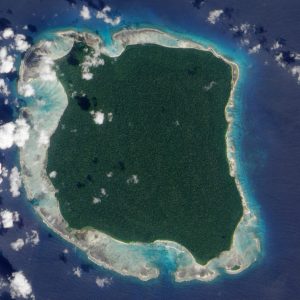
7. Lascaux Caves, France
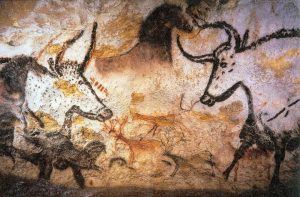
8. Vatican Secret Archives, Vatican City

9. Svalbard Global Seed Vault, Norway

10. Mausoleum of the First Qin Emperor, China

11. Bank of England Vaults, UK

very interesting blog love it
LEAVE A REPLY Cancel reply
Save my name, email, and website in this browser for the next time I comment.
Beyond Borders: Forbidden Places

Embark on a journey to the forbidden, where mystery and secrecy intertwine. Delve into enigmatic locales and explore the uncharted territories that defy conventional boundaries. Uncover the stories and secrets that have kept these places off-limits to the curious. Are you ready to go beyond the ordinary? Click to explore more.

19 Places That People Are Forbidden to Visit
F or the most part, the world is your oyster. However, some places exist in the world that people are forbidden to visit. Some governments ban places because they’re dangerous to people, or humans are dangerous to the animals and habitats nearby. Others hold secrets governments and individuals definitely want to keep from the public.
If you want to learn more about these forbidden places, you’ll have to keep reading below.
1. Ducle Base
This article is starting with a pretty controversial one. Certain groups claim that under Dulce, New Mexico, there’s a hidden base for the US government. According to conspiracy theorists, there’s a compound somewhere near the town that is host to all sorts of experiments, or even aliens. If true, it would be the ultimate forbidden place.
2. Poveglia Island
This island has a heavy history filled with death. It was once used as a quarantine station for the plague, holding over 160 thousand people on the island. In 1922, Italy used the island as a mental hospital. There were rumors it was corrupt and the doctors often tortured the inhabitants. It’s one of the most haunted places on earth, and the soil is at least 50 percent human remains, according to certain statements.
3. North Brother Island
Like Poveglia Island, North Brother Island started as a quarantine hospital. The United States designated the island for those with typhoid and was home to Typhoid Mary. Then, it became a rehabilitation center. After the center was shut down, North Brother Island became a bird sanctuary.
4. Heard Island
There are two volcanoes, still active, on Heard Island. But that’s not what makes the island forbidden. The island is protected as a nature reserve. The government only allows people to visit the island for scientific research.
5. Bohemian Grove
Bohemian Grove is 2,700 acres. It’s an extremely private gentleman’s club where some of the most prominent men in the world get together and talk. Friends and family members are allowed on occasion, but they must follow the rules closely and be off the property by a specific time.
6. Ise Grand Shrine
To protect this temple, only the royal family is allowed to enter, and only on rare occasions. There is one other exception. About every 20 years, the temple is rebuilt to maintain its strength and Shinto traditions.
Area 51 isn’t entirely forbidden. No standard citizen has a chance of entering the gates. Only specific government bodies, like high-level scientists and the military, are allowed in the base. Rumors say that the base is home to new weapons for the army, or perhaps a site for extra-terrestrial research.
8. Snake Island
This is an island you probably wouldn’t want to go to, even if you could. The Brazilian government has banned travelers due to how deadly the island is. This island earned its name by having the highest concentration of pit vipers in the world.
9. Surtsey Island
The reason Surtsey is forbidden is because of its scientific significance. It’s the newest landform in the world created by volcanoes, breaking the surface in the 1960s. Only scientists researching the island have permission to visit.
10. Tomb of Qin Shi Huang
There is still a lot to discover about this tomb and the soldiers that have remained standing for over 2,000 years. To respect the site, the Tomb Qin Shi Huang has been blocked by the government and no excavation is allowed.
11. The Vatican Secret Archives
The Vatican Secret Archives aren’t actually a secret. They’re just incredibly private. The archives hold all sorts of information related to the Pope and the history of the church and religion. The Vatican permits some researchers and members of the church, but that’s it.
12. Gruinard Island
The government bought Gruinard Island with the specific purpose of testing war weapons. Specifically, they tested a form of anthrax on the island. Though the weapons ended up never being used in the war, the weapons were tested on the island. The island is supposedly safe now , but is still not open to the public thanks to a private buyer.
13. Niihau Island
There are roughly 160 people on Niihau island, but only this group of people and the US Navy are allowed on the island. The owners of the island promised to use the land to protect the traditional Hawaiian language and culture.
14. Pravcicka Brana
The Pravcicka Brana is a naturally formed arch. It used to be a huge tourist attraction. However, the constant walking over the arch by tourists has eroded the structure. It’s ready to collapse at any time, and due to the danger, is forbidden.
15. Coca-Cola’s Vault
Though the vault is located in a fairly popular tourist attraction for fans of the soda, the vault itself is forbidden. This is supposedly because it’s the location of the recipe for Coca-Cola, a closely guarded secret.
16. Mezhgorye
Though this is technically just a town in Russia, it’s top-secret and forbidden to anyone not personally approved by Vladimir Putin. No one knows for sure what’s there, but some say that it’s home to nuclear weapons.
17. North Sentinel Island
North Sentinel Island isn’t home to anything secretive. However, it is very dangerous. It’s home to one of the last communities not touched by modern civilization. These people are heavily protected because they’ve gathered no immunity from our modern diseases. Interactions with the islanders could lead to a high rate of death and infection.
18. Lascaux Caves
For many archaeologists, there’s nothing more interesting than the cave paintings in Lascaux Cave. They are over 17,000 years old. The caves had to be closed off to the public as the high levels of heat and carbon dioxide in the caves damaged the paintings.
19. Svalbard Global Seed Vault
Svalbard Global Seed Vault is home to over 900 thousand seeds from all over the world. The main purpose of this storage vault is to have seeds in case humans manage to kill off all life on Earth. It’s also great for studying plants that are extinct or going extinct.
Summary of Places People Are Forbidden to Visit
Love Animals as much as we do? Make sure to Follow and Like us on MSN. Have feedback? Add a comment below!
- The 75 Most Iconic Places Around the World – In Alphabetical Order by Continent!
- 9 Absolutely Bizarre Laws in Oregon That Are Still Against the Law
- 23 Absolutely Bizarre Laws in New York That Are Still Illegal
The post 19 Places That People Are Forbidden to Visit appeared first on A-Z Animals .
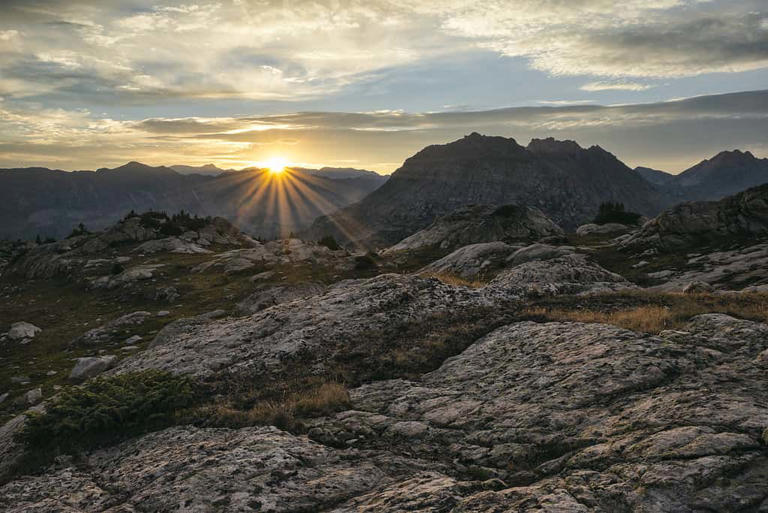
What does the Bible say about eclipses? Some see evidence of higher power, warnings

We're less than two weeks away from the astronomical event of the decade: A total eclipse of the sun , which will grace the nation's skies from Texas to Maine on the afternoon of Monday, April 8 .
Millions of people are expected to travel to see the spectacle, which also will attract scientists from across the country to study its unique effects .
On the spiritual side of things, many also are preparing to use the eclipse as a time of reflection and prayer, though many also see the celestial events as bad omens.
Eclipses have inspired fear and awe among civilizations throughout history, from the Aztecs to the ancient Hindus. They're also associated with some major religious events, including the darkness that accompanied Jesus’ crucifixion in Christianity and, in Islam, the passing of the Prophet Muhammad’s son, Ibrahim.
What time is the solar eclipse? Search your ZIP code for a viewing guide
What does the Bible say about eclipses?
Celestial darkness is mentioned in sections of the Bible depicting the crucifixion of Jesus Christ — Matthew 27, Mark 15 and Luke 23.
Mark 15:33 reads: "And when the sixth hour had come, there was darkness over the whole land until the ninth hour."
James Willis, an assistant professor of practice for religion at the University of Indianapolis, told USAToday that such references often emphasize the power of God over the cosmos.
“What we today see as an astronomical event, people previously interpreted as having life-and-death significance," Willis said.
Other references to eclipses include the book of Joshua, which recounts a day the sun stood still, as well as the book of Revelation. End times scholars often interpret celestial phenomena like solar eclipses, lunar eclipses and meteors as signs heralding significant future events, including the Rapture.
Is there a solar eclipse Bible prophesy?
In the Old Testament, prophets often describe eclipses or celestial phenomena as illustrations of a higher power at work when prophesizing, according to the Jerusalem Post.
- Isaiah 13:10: "The stars of heaven and their constellations will not show their light. The rising sun will be darkened and the moon will not give its light."
- Ezekiel 32:7: "When I extinguish you, I will cover the heavens and darken their stars; I will cover the sun with a cloud, and the moon will not give its light."
- Isaiah 38:8: "I will make the shadow cast by the sun go back the ten steps it has gone down on the stairway of Ahaz."
- In the book of Joel, a Jewish prophetic text, Joel 2:10; 2:31: "The earth shakes, the sky trembles, the sun and moon are darkened, and the stars no longer shine... The sun will be turned to darkness and the moon to blood before the great and dreadful day of the LORD." Also, Joel 3:15: "The sun and moon will be darkened, and the stars no longer shine."
Eclipse in Choctaw culture
Earlier this month, in the Choctaw Nation newspaper Biskinik, a recurring column exploring Choctaw culture noted the sun was considered to bring life and good fortune; for some communities, when solar eclipses occurred, it was as if great black squirrels in the sky were devouring the sun. In response, all were called upon to make noise in an effort to frighten them away.
Eclipses in Islam offers an occasion to pray
During the lifetime of the Prophet Muhammad, there was a solar eclipse on the day his son Ibrahim died.
As the story goes, speculation spread among Muhammad’s followers that even the sun and moon were grieving his loss. In response, he dispelled the notion that the eclipse was due to a person's death or life, and instead called them to pray until the eclipse is clear.
While Islam’s eclipse prayer is not a mandatory one, many still take time to recite it.
Looking for free solar eclipse glasses? These OKC libraries are handing them out
A warning of God’s imminent wrath?
Perspectives on eclipses vary widely, but some see celestial happenings as a warning of God’s imminent wrath; some have even claimed they bear political significance . In November 2022, some ultraconservative Christian pastors said the approaching blood moon lunar eclipse portended a surge of Republican midterm wins.
More recently, Anne Graham Lotz, daughter of iconic evangelist Billy Graham, has seen speculation among some that the combined paths over the United States of this year’s eclipse and the previous two solar eclipses appear to mimic the shapes of the first and last letters of the Hebrew alphabet — in other words, the beginning and the end.
“Maybe people are reading too much into it,” she told USAToday recently. “But when you look at the world, you don’t need an eclipse to know that things are getting really dangerous. Maybe it’s telling us it’s time to get right with God and the people in our lives, so that we have no regrets.”
Contributing: Marc Ramirez, USAToday

IMAGES
VIDEO
COMMENTS
Riba (Interest) is never allowed in Islam because it is a system that makes poor the poorest and rich the richest! 5. Men wearing Silk and Gold. Silk and Gold are Haram on Men. Because these two things are attributed to women only, and Islam prohibits Men from being like Women, and Women from being like Men. 6.
Going to the Dead Sea for Tourism. Yes, scholars do mention that the Dead Sea is where Allah's punishment descended on the people of Lut (peace be upon him), and as such Muslims should not go there for tourism. The Prophet (peace and blessings be upon him) and his Companions were once passing by the place of Ashab al-Hijr, who were Thamud ...
Pilgrims circulating the Kaaba within Al-Masjid al-Haram (the holiest site) during Hajj in the holy city of Mecca, Saudi Arabia. The holiest sites in Islam are predominantly located in the Arabian Peninsula and the Levant. While the significance of most places typically varies depending on the Islamic sect, there is a consensus across all mainstream branches of the religion that affirms three ...
Haram (/ h ə ˈ r ɑː m, h æ ˈ-, h ɑː ˈ-,-ˈ r æ m /; Arabic: حَرَام ḥarām [ħɑˈrɑːm]) is an Arabic term meaning 'forbidden'.: 471 This may refer to either something sacred to which access is not allowed to the people who are not in a state of purity or who are not initiated into the sacred knowledge; or, in direct contrast, to an evil and thus "sinful action that is ...
The destiny of this long-forbidden city, rich in World Heritage Sites, changed when Crown Prince Mohammed bin Salman made it a flagship project of his 'Vision 2030' plan.
Going to the Dead Sea for Tourism. Yes, scholars do mention that the Dead Sea is where Allah's punishment descended on the people of Lut (peace be upon him), and as such Muslims should not go there for tourism. The Prophet (peace and blessings be upon him) and his Companions were once passing by the place of Ashab al-Hijr, who were Thamud ...
Abu Hurayrah, agreed upon that. So, it is unlawful to travel to any place in the world to seek blessing or pray or do any other acts of worship except the three mentioned mosques. We conclude by saying " it is unlawful to travel in order to visit any mosque on earth except the three mosques. But it is lawful to travel to visit scholars and ...
Muslims do not believe in making images of Allah, Muhammad, any other prophets, or any person or animal. There are two reasons for this. One is that the worship of images is forbidden in Islam. The other reason is that no artist's representation of Allah's creation would be able to show its true beauty. It is a way of honoring Allah.
Madain Saleh (translated as Cities of [Prophet] Saleh and also known as cities of Al-Hijr in the Quran) is a collection of small sites located in North Western Saudi-Arabia near the town of Al-Ula…
Here's a look at five of Islam's most important sites, each one a stunning icon of the faith. 1. Mecca, Saudi Arabia. Of course, Mecca tops the list. This most holy city was the birthplace of ...
When the question arises, ' Can non-Muslims go to Mecca ' the answer is No. Non-Muslims are not allowed to enter the holy cities of Mecca in Saudi Arabia. The reasons for this restriction are deeply rooted in the Islamic faith and history. Mecca and Medina are considered the holiest cities in Islam and are revered by Muslims worldwide.
Madain Saleh, a UNESCO World Heritage site located there, is a 2,000-year-old city carved into desert rocks by the Nabateans, the pre-Islamic Arab people that also built Petra in neighboring Jordan.
Masjid Al-Aqsa ("the Farthest Mosque"), also known as the "Al Aqsa compound", is a holy site in Shia and Sunni Islam and is located in the Old City of Jerusalem, and is widely regarded by Jews as the Temple Mount, the site of the Holy Temple. It includes the Qibli mosque and the Dome of the Rock. It is the third holiest site in Islam.
He especially cursed women who tended to visit graves [and commit forbidden acts, like wailing]. The Prophet's, sallallaahu 'alayhi wa sallam , guidance involves prohibiting treading over graves, sitting or reclining on them, glorifying the deceased by praying at or by their burial sites, visiting them habitually [in veneration] or ...
Coca-Cola, of course, denies that this formula is the same one they have locked away. 7. Uluru (Formerly Ayers Rock) One of the world's most famous forbidden places hasn't been forbidden for ...
Assalamu aleykum va rahmatullahAs we know it is forbidden to travel to non-muslim countries for purposes of tourism or unless there is a valid shari excuse1- What if a country that you want to travel to is a non-muslim country but it has a region or some regions inside itself where only or mostly muslims live Is travel for tourism to this region only permitted in this case even though this ...
Women are permitted to visit a graveyard on condition: They are accompanied by a mahram. The accompanying of a mahram is meant to curb any possible fitnah. The visit is a means of remembering death and conscientizing oneself of life after death and preparing for it. [4] And Allah Ta'āla Knows Best. AbdulMannan Nizami. Student Darul Iftaa ...
Now, do visit them, for it (visiting graves) makes one ascetic of the world and reminds one of the hereafter." (Sunan Ibn Majah, no. 1571) 5) Sayyida A'isha (may Allah be pleased with her) says: "The Messenger of Allah (Allah bless him & give him peace) gave permission in the visitation of graves." (Sunan Ibn Majah, no. 1570) The above ...
Anas narrates that the Prophet (peace and blessings be upon him)ﷺ said, "I forbade you to visit the graves then it appeared to me that they soften the heart, bring tears to the eyes, and remind one of the hereafter." (Ahmad) Abu Huraira, relates the Prophet's words, "Visit graves, for it reminds one of his death." (Sahih Muslim).
So, here are 11 such forbidden places from around the world. 1. The Dome of the Rock, Jerusalem. Considered one of the holiest sites in the world, the Temple Mount is sacred to both Jews and Muslims, however, the even more holy gold-topped Islamic shrine of the Dome of the Rock is not open to non-Muslims. 2.
WHY PROPHET (SAW) DON'T WANT YOU TO VISIT THIS CITY IN SAUDI ARABIA Subscribe to our channel: https://bit.ly/3sm8WUx
F or the most part, the world is your oyster. However, some places exist in the world that people are forbidden to visit. Some governments ban places because they're dangerous to people, or ...
Banned from reporting rape. Islam considers the witness reported by a man to be equal to that of two women. Zina or adultery cannot be alleged by a woman. The Sharia law limits a woman's ability ...
Millions of people are expected to travel to see the spectacle, which also will attract scientists from across the country to study its unique effects. On the spiritual side of things, many also are preparing to use the eclipse as a time of reflection and prayer, though many also see the celestial events as bad omens.